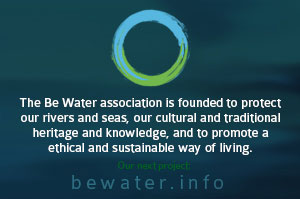
197 km, 110 locks, 10 canal bridges, 6 tunnels. And so many people and sceneries… Spectacular! These are the numbers and the words of our last few days of travelling, but there’s much more to tell. Naturally.
 There are the wild landscapes of the Marne side-canal, postcard-worthy. Herd of cattle running away at our approach, shaking the earth under their feet. And water, of course. We drink it straight from the canal: It’s potable and transparent down to 4 metres.
There are the wild landscapes of the Marne side-canal, postcard-worthy. Herd of cattle running away at our approach, shaking the earth under their feet. And water, of course. We drink it straight from the canal: It’s potable and transparent down to 4 metres.
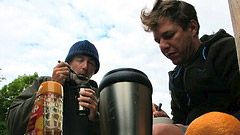 There are breakfasts in the midst of the steam rising from the canals, rain-wet nights, burnt days, opposite winds, handshakes from calloused hands, honest and warm hands. Kisses thrown in the air by a Turkish kid that keeps greeting us from the distance, so happy to read that word… Istanbul!
There are breakfasts in the midst of the steam rising from the canals, rain-wet nights, burnt days, opposite winds, handshakes from calloused hands, honest and warm hands. Kisses thrown in the air by a Turkish kid that keeps greeting us from the distance, so happy to read that word… Istanbul!
And the enraptured look of a little lady that stares at us from the bank of the canal.
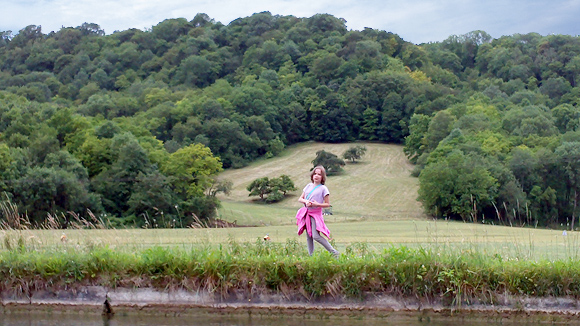
Then there are our hands, as hard and worn-out as an old buffalo leather slipper.
 There’s the old hearth of Nazim Hickmet, great Turkish poet of peace and freedom, and our own hearts, getting softer day by day thanks to the joy that we feel and get others to feel.
There’s the old hearth of Nazim Hickmet, great Turkish poet of peace and freedom, and our own hearts, getting softer day by day thanks to the joy that we feel and get others to feel.
We cannot forget the kindness of so many people.
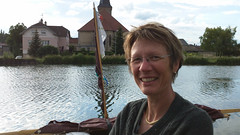 Such as Chantal in Treveray, that takes me to join the rest of the crew (I was left behind to update the website, and a long walk was in front of me), and the Mayor of Treveray who helps me to send an important e-mail to the italian radio;
Such as Chantal in Treveray, that takes me to join the rest of the crew (I was left behind to update the website, and a long walk was in front of me), and the Mayor of Treveray who helps me to send an important e-mail to the italian radio;
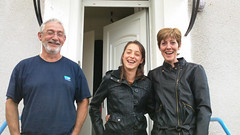 And Jean, an “eclusier” (lock-keeper), a profession that’s quickly disappearing due to the automations required by the cost-cuts. He invites us in his home, offering Champagne, along with his charming wife and his nice daughter that the next day makes us a gift: A postcard depicting this very same lock many years ago;
And Jean, an “eclusier” (lock-keeper), a profession that’s quickly disappearing due to the automations required by the cost-cuts. He invites us in his home, offering Champagne, along with his charming wife and his nice daughter that the next day makes us a gift: A postcard depicting this very same lock many years ago;
 And yet again Sara and Bertrand in Toul that take us aboard their boat for breakfast, also making us sandwiches for the next day.
And yet again Sara and Bertrand in Toul that take us aboard their boat for breakfast, also making us sandwiches for the next day.
And a thousand other people that gave me, Bruno and Fine so many emotions. And help.
 The landscape is now hilly: We’ve got up and down more than 110 times, passing 25 locks in just one day. The journey is intense, it’s so difficult to pay justice to all the places in such a short report, however I’ll try to put together a summary of what’s happened in the past week.
The landscape is now hilly: We’ve got up and down more than 110 times, passing 25 locks in just one day. The journey is intense, it’s so difficult to pay justice to all the places in such a short report, however I’ll try to put together a summary of what’s happened in the past week.
First of all Berry-au-Bac, wonderful and perched: The French Renaissance. Here, we have a meeting in the headquarters of Vnf, where we gather kindness and information about the lock system that ever surprises us.
A century long, magnificent endeavour that, at a very high price in terms of money and effort, is still maintained. Thanks Vnf and thanks France for this gift.
Sailing and rowing on these waters and canals, passing these locks, bridges, tunnels always makes us think about about who worked and still works hard to keep it all functioning.
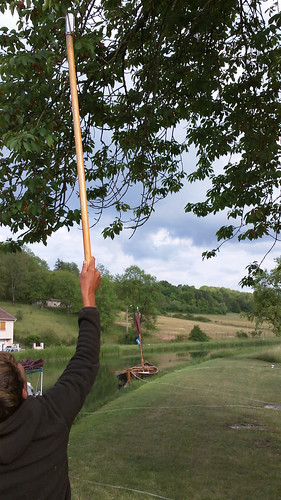 In Treveray, we moor under a cherry tree and Josephine jumps over Bruno’s shoulders to pick a few of these tasty fruits (we’re now officially gatherers, although still nomadic at heart!).
In Treveray, we moor under a cherry tree and Josephine jumps over Bruno’s shoulders to pick a few of these tasty fruits (we’re now officially gatherers, although still nomadic at heart!).
Then, we enter a bar where everybody listens carefully to our story. We recall with true pleasure the help received by the Mayor, by Madame Dal Zotto and by Chantal.
The next afternoon we literally sail on the water-lilies, getting past the 29th lock along the Marne-Rhine canal. This atmosphere reminds me of Claude Monet paintings. The water is just fantastic, so much that we drink it. We indulge in an unhortodox mooring, casting the anchor on the canal banks!

Along the canal, from the boat, we pick other cherries and strawberries: Delicious!
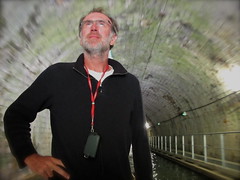 But we’re waited by the second long tunnel of our journey, that of Mauvages, just slightly shorter than the Suterrain de Riqueval. This tunnel was built from the 1841 to the 1846: It’s about 4.800 metres long, wet and dark, and equipped with the same system used in Riqueval, an electric towboat. But Captain Jack and his crew are already accustomed to this!
But we’re waited by the second long tunnel of our journey, that of Mauvages, just slightly shorter than the Suterrain de Riqueval. This tunnel was built from the 1841 to the 1846: It’s about 4.800 metres long, wet and dark, and equipped with the same system used in Riqueval, an electric towboat. But Captain Jack and his crew are already accustomed to this!
 We stop for the night in Void, where Elvis from Vnf gives us a pen. The next morning we have breakfast over a roman bridge with a baguette cooked in a wood-fired oven. Then we get to Toul, fortified city, meeting Jean, Sara and Bertrand in a new, magnificent harbour. Here we visit the wonderful Cathedral: What a chance to show off my long-past architecture study with Bruno and Fine!
We stop for the night in Void, where Elvis from Vnf gives us a pen. The next morning we have breakfast over a roman bridge with a baguette cooked in a wood-fired oven. Then we get to Toul, fortified city, meeting Jean, Sara and Bertrand in a new, magnificent harbour. Here we visit the wonderful Cathedral: What a chance to show off my long-past architecture study with Bruno and Fine!
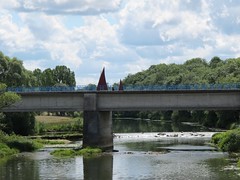 We get aboard once again heading to Nancy, sailing over the bridge-canal on the Meuse and rowing under another long tunnel: After 36 km we eventually enter in a real river, the Moselle.
We get aboard once again heading to Nancy, sailing over the bridge-canal on the Meuse and rowing under another long tunnel: After 36 km we eventually enter in a real river, the Moselle.
A great Arcadia Felix scenery welcomes us, allowing for a nice sailing. The river gets much wider, such are the locks and the inevitable Peniche, over 100 metres long.
Here, the landscape is still wild , with little intensive agriculture and many grasslands. Given the water quality, the nature is nice and healthy, as confirmed by the presence of water-lilies, trouts, crabs, chars and basses.

On the way, the Moselle gets more cloudy: Industries and intensive agriculture seem to pollute the river and its bank a bit more. Ill-mannered people do the rest.
 In Nancy, a city rich in history and culture, we immediately see a lot of bikes that can be used in a way that seems to work very well. It’s called Velostan, based on 25 hubs scattered around the city centre: Here everyone can pick up and leave the bikes through a subscription system of variable duration.
In Nancy, a city rich in history and culture, we immediately see a lot of bikes that can be used in a way that seems to work very well. It’s called Velostan, based on 25 hubs scattered around the city centre: Here everyone can pick up and leave the bikes through a subscription system of variable duration.
The bikes are very nice looking and seem quite strong too.
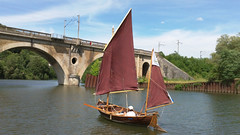 France is still sweet. Despite the Kilometres already travelled, 800 so far, we’re convinced to run too fast, leaving behind so many things and missing opportunities.
France is still sweet. Despite the Kilometres already travelled, 800 so far, we’re convinced to run too fast, leaving behind so many things and missing opportunities.
But we still learn so much, every day. A wonderful experience.
I feel sad thinking about the choices of some “big fishes” of the past that have taken away from Italy the pleasure of fluvial navigation, hailing the name of a regressive progress that has wasted the work of thousand of people.
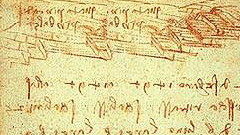 Among those, there was a gentleman called Leonardo, coming from a tiny village in Tuscany, Vinci. By chance, he had dedicated great energies and efforts in the study of water and waterways. His water stair starting in Pavia has been left in a totally neglected condition.
Among those, there was a gentleman called Leonardo, coming from a tiny village in Tuscany, Vinci. By chance, he had dedicated great energies and efforts in the study of water and waterways. His water stair starting in Pavia has been left in a totally neglected condition.
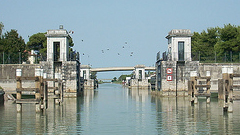 I’m also sorry because at every lock passed, we’re at 157 so far, I can see the doors that Leonardo invented five centuries ago, and are so called “vincian”. They’re still working beautifully all around the world.
I’m also sorry because at every lock passed, we’re at 157 so far, I can see the doors that Leonardo invented five centuries ago, and are so called “vincian”. They’re still working beautifully all around the world.
That’s life. Be water! Giacomo
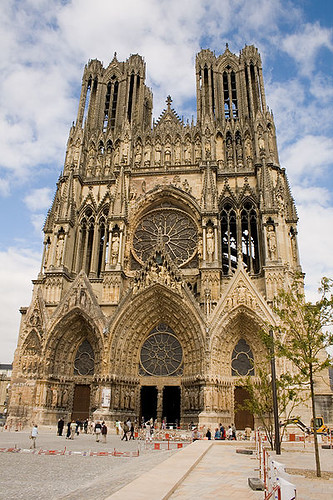
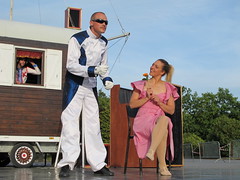 Fine will stop here a little longer to make a video about one of them, Magali. You can watch the final result at bottom page, it’s way better than a thousand words.
Fine will stop here a little longer to make a video about one of them, Magali. You can watch the final result at bottom page, it’s way better than a thousand words. The permission from VNF doesn’t arrive and I show to Mr Michel Marteau the e-mail sent to their Lille’s offices. A firm “No” turns at first to a “Maybe” and then, following a phone call full of laughs (it’s not every day that you meet two madmen rowing to Istanbul), to a very warm and participative “Yes”.
The permission from VNF doesn’t arrive and I show to Mr Michel Marteau the e-mail sent to their Lille’s offices. A firm “No” turns at first to a “Maybe” and then, following a phone call full of laughs (it’s not every day that you meet two madmen rowing to Istanbul), to a very warm and participative “Yes”.
 Our arrival in Reims is quite funny. The canal flows in the very hearth of the city, between two high-traffic roads: A real mayhem. Everybody stare at us like we’re from another planet, maybe martians (o humans…). Paradox in all of this mess, we cross the first other rowboat in France: two guys in a double scull.
Our arrival in Reims is quite funny. The canal flows in the very hearth of the city, between two high-traffic roads: A real mayhem. Everybody stare at us like we’re from another planet, maybe martians (o humans…). Paradox in all of this mess, we cross the first other rowboat in France: two guys in a double scull.
 We discovered that its name comes from “Remus”, funnily the Italian word for “oar”, brother of Romulus founder of Rome!! According to the (obviously roman) legend, Remus founded Reims giving his name to the first people living in the area too. Even today the inhabitants are called Rémois.
We discovered that its name comes from “Remus”, funnily the Italian word for “oar”, brother of Romulus founder of Rome!! According to the (obviously roman) legend, Remus founded Reims giving his name to the first people living in the area too. Even today the inhabitants are called Rémois.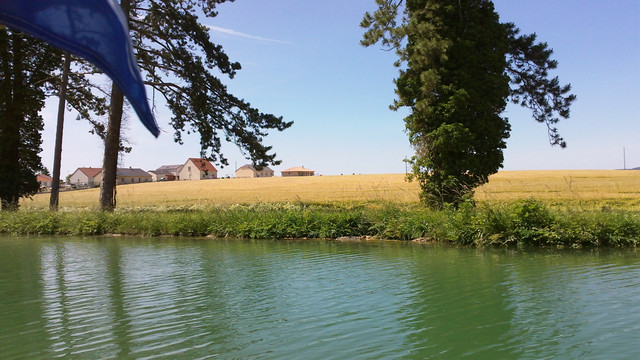
 This leg is very hard and made even harder by the opposite wind. Thanksfully we take comfort from a few wild strawberries picked on the banks of the canal from aboard Clodia. Sweat and sweets!!
This leg is very hard and made even harder by the opposite wind. Thanksfully we take comfort from a few wild strawberries picked on the banks of the canal from aboard Clodia. Sweat and sweets!!  In Port de Vaudemanges we’ll have one of the best time of our rich journey. In a perfect environment, a small “liveaboard” community has chosen to restore old boats and get free from brick houses. They seem happier. Isabelle, judge, welcomes us and in a blink of an eye we arrange a collective dinner for many friends.
In Port de Vaudemanges we’ll have one of the best time of our rich journey. In a perfect environment, a small “liveaboard” community has chosen to restore old boats and get free from brick houses. They seem happier. Isabelle, judge, welcomes us and in a blink of an eye we arrange a collective dinner for many friends.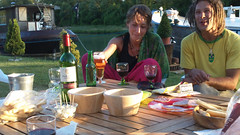 One of them, Maddy Lecyn, has restored a Peniche belonging to Serge and Isabelle, equipping it with a recording studio, a place of arts that he’s now planning to take around Europe to carry aboard artists, music and beauty. His website is
One of them, Maddy Lecyn, has restored a Peniche belonging to Serge and Isabelle, equipping it with a recording studio, a place of arts that he’s now planning to take around Europe to carry aboard artists, music and beauty. His website is  On board, James cooks fantastic prawns and Paolo improvises a tipical Italian meal: Spaghetti (that he has brought from home, of course) for 10 people. In a 5.74 mt long boat, I can tell you that cooking is not that easy.
On board, James cooks fantastic prawns and Paolo improvises a tipical Italian meal: Spaghetti (that he has brought from home, of course) for 10 people. In a 5.74 mt long boat, I can tell you that cooking is not that easy.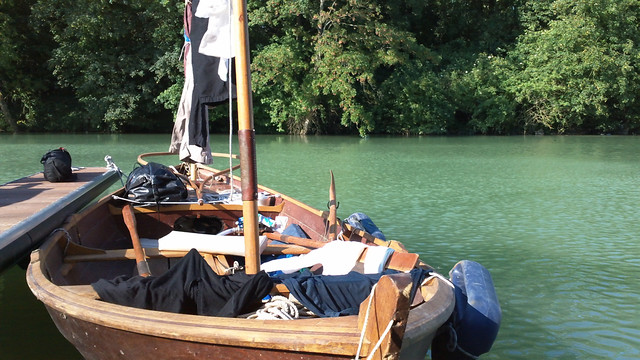
 It’s time to go, to try, to live the journey. And to let Clodia slide over the waters to Istanbul.
It’s time to go, to try, to live the journey. And to let Clodia slide over the waters to Istanbul.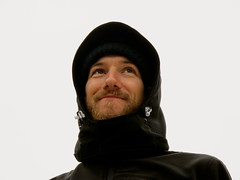

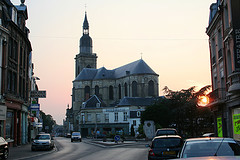 We left our story in Cambrai, on the Canal De Saint Quentin: The city is nice and rich in history. Funnily enough, here in 1508 Pope Julius II created the
We left our story in Cambrai, on the Canal De Saint Quentin: The city is nice and rich in history. Funnily enough, here in 1508 Pope Julius II created the 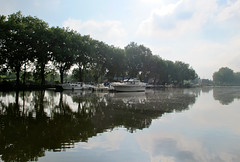 Thanksfully we manage to get a lift by a very kind friend, met the night before in the beautiful Port of Cambrai, where Captain Jean Luc granted us free mooring. Julien Debut, that’s his name, is very helpful and takes us to the meeting point just after work (in an italian pizzeria, by the way).
Thanksfully we manage to get a lift by a very kind friend, met the night before in the beautiful Port of Cambrai, where Captain Jean Luc granted us free mooring. Julien Debut, that’s his name, is very helpful and takes us to the meeting point just after work (in an italian pizzeria, by the way).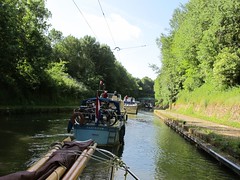 In these days we get through wo tunnels, the most important of them being the Suterrain de Riqueval, 5.671 metres long, that leaves us breathless. An electrical towboat, equipped with a long chain and connected to overhead lines, called “Toeur”, pulls a convoy of six boats. We are at the tail end. This is one of the two French tunnels using this system: The other one is located in Mauvages, on the channel connecting the Marne to the Rhine.
In these days we get through wo tunnels, the most important of them being the Suterrain de Riqueval, 5.671 metres long, that leaves us breathless. An electrical towboat, equipped with a long chain and connected to overhead lines, called “Toeur”, pulls a convoy of six boats. We are at the tail end. This is one of the two French tunnels using this system: The other one is located in Mauvages, on the channel connecting the Marne to the Rhine.
 We soffer and tow the boat from the bank with a lace, but eventually we enter the Canal de l’Oise à l’Aisne.
We soffer and tow the boat from the bank with a lace, but eventually we enter the Canal de l’Oise à l’Aisne.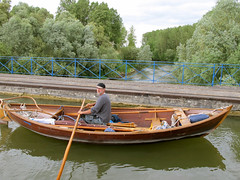 We cross the first suspended bridge, better still the first “suspended channel”: We’re rowing 15 metres over the Ailette river! Reached Guny, we sleep in a gorgeous area dedicated to sailors, and equipped with haulage slipway, bollards, etc: An example to be followed. The night is cold and windy. In the morning we decide to visit the boulangerie for a croissant and a baguette, honouring local traditions…
We cross the first suspended bridge, better still the first “suspended channel”: We’re rowing 15 metres over the Ailette river! Reached Guny, we sleep in a gorgeous area dedicated to sailors, and equipped with haulage slipway, bollards, etc: An example to be followed. The night is cold and windy. In the morning we decide to visit the boulangerie for a croissant and a baguette, honouring local traditions…
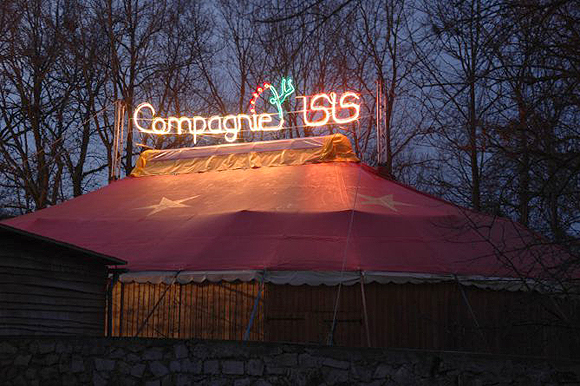
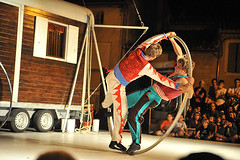 There’s also a Cambodian company getting ready to move on. They invite us to eat tasty crepes with them, in a beautiful old stone house once belonged to their philanthropist grandfather and actress mother.
There’s also a Cambodian company getting ready to move on. They invite us to eat tasty crepes with them, in a beautiful old stone house once belonged to their philanthropist grandfather and actress mother.
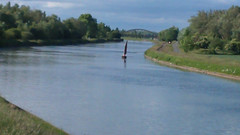 I’m back on board.
I’m back on board.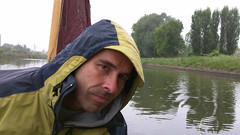 I joined them in Bethune along with Sandro, a dear friend from Venice that is now our second “sailor for a week” (or even more…)!
I joined them in Bethune along with Sandro, a dear friend from Venice that is now our second “sailor for a week” (or even more…)!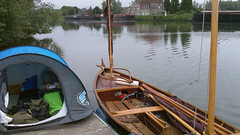 We leave from Bethune very early in the morning, heading to Douai: Sandro and I take over from Bruno and Francesco.
We leave from Bethune very early in the morning, heading to Douai: Sandro and I take over from Bruno and Francesco.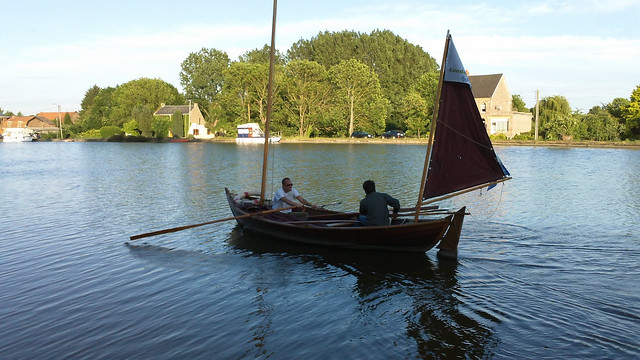
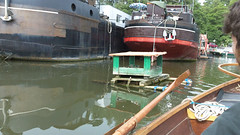 The “Grand Gabarit”, a canal running from Bethune to Douai, is rather dirty, full of dead fishes and lots of commercial boats raising annoying waves. Fine and Bruno collect two bags full of rubbish: From now on we’ll try to give our contribution to the environment. Thanks to them for this simple yet effective idea.
The “Grand Gabarit”, a canal running from Bethune to Douai, is rather dirty, full of dead fishes and lots of commercial boats raising annoying waves. Fine and Bruno collect two bags full of rubbish: From now on we’ll try to give our contribution to the environment. Thanks to them for this simple yet effective idea. After 40 km of navigation, we stop for the night in Etrun, close to the access to Saint Quentin canal. We moor in a nice basin illuminated by a mediterranean light. Here we rejoin our new English friends, waiting to offer us plenty of wine and beer. For dinner we have a tasty rice cooked by Sandro. We squeeze aboard Clodia: five people in five metres, we’re strong and happy.
After 40 km of navigation, we stop for the night in Etrun, close to the access to Saint Quentin canal. We moor in a nice basin illuminated by a mediterranean light. Here we rejoin our new English friends, waiting to offer us plenty of wine and beer. For dinner we have a tasty rice cooked by Sandro. We squeeze aboard Clodia: five people in five metres, we’re strong and happy.
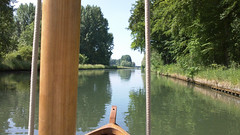 Saint Quentin canal is wonderful: There are many locks, but very well organised. Passing is easy and fast, I wish I could say the same elsewhere.
Saint Quentin canal is wonderful: There are many locks, but very well organised. Passing is easy and fast, I wish I could say the same elsewhere.
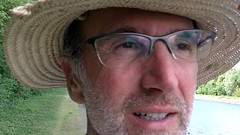 Tomorrow we’ll take the notorious “Souterrain de Riqueval”, a tunnel 5670 mt long, not aerated. To get through, we rely on the electrical ferry that goes forth and back twice a day: At 9 in the morning and at 5 in the afternoon. My travel mates are fantastic in a very tough condition. We covered 170 km in four days, very little by sail.
Tomorrow we’ll take the notorious “Souterrain de Riqueval”, a tunnel 5670 mt long, not aerated. To get through, we rely on the electrical ferry that goes forth and back twice a day: At 9 in the morning and at 5 in the afternoon. My travel mates are fantastic in a very tough condition. We covered 170 km in four days, very little by sail.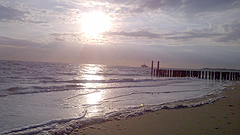 After hours from Jasmine Lane
After hours from Jasmine Lane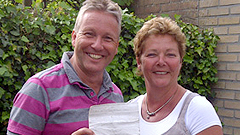 We found it, during a evening walk with our dog, at the beach of Dishoek near Vlissingen in Holland. We already visited the website Man on the River and we wish this project a lot of luck. Also thanks for the t-shirt offer.
We found it, during a evening walk with our dog, at the beach of Dishoek near Vlissingen in Holland. We already visited the website Man on the River and we wish this project a lot of luck. Also thanks for the t-shirt offer.
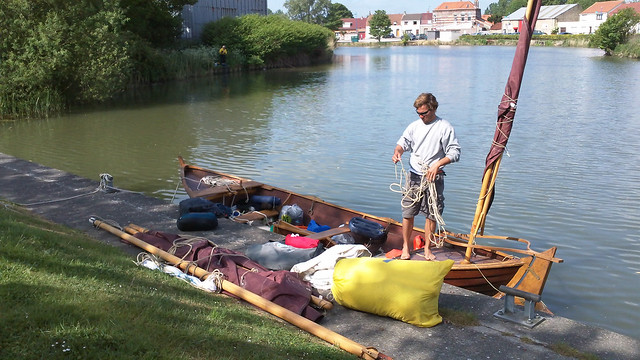
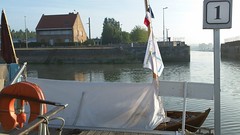
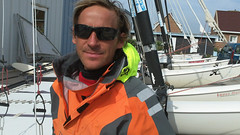
 They help us without asking for anything in return or spending useless words, gentleman to gentleman. The morning after we sail for a couple of km, up to the end of the canal: Maurice, a big man with a smiling face, is waiting for us with his farm tractor. He tows Clodia out of the water for a few metres and then in the slipway beyond the lock. We’re even escorted by the police (thanks to Stefan and Jean Claude) but free once again!
They help us without asking for anything in return or spending useless words, gentleman to gentleman. The morning after we sail for a couple of km, up to the end of the canal: Maurice, a big man with a smiling face, is waiting for us with his farm tractor. He tows Clodia out of the water for a few metres and then in the slipway beyond the lock. We’re even escorted by the police (thanks to Stefan and Jean Claude) but free once again!



 After eight hours we reach Arques, where the support boat is moored. The little port is lovely, nestled in the bend of a secondary canal and surrounded by nature. Silence and peace.
After eight hours we reach Arques, where the support boat is moored. The little port is lovely, nestled in the bend of a secondary canal and surrounded by nature. Silence and peace. In Saint Omer, we look for help: I have to get back to Venice for my health check-up and we pay visit to a few travel agencies to get tickets with our scarce resources (Paolo will get back to Bologna too). In the
In Saint Omer, we look for help: I have to get back to Venice for my health check-up and we pay visit to a few travel agencies to get tickets with our scarce resources (Paolo will get back to Bologna too). In the 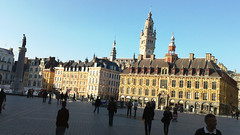 On the way back, we arranged a meeting in Lille (very nice city of the Flanders) to see the kind representatives of the VNF, the mighty company managing all the fluvial navigation network in France.
On the way back, we arranged a meeting in Lille (very nice city of the Flanders) to see the kind representatives of the VNF, the mighty company managing all the fluvial navigation network in France.
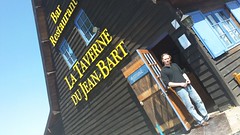
 We could never have done it without the help of Chalky, a sailor friend, who escorted us all the way from Ramsgate to Gravelines.
We could never have done it without the help of Chalky, a sailor friend, who escorted us all the way from Ramsgate to Gravelines. This is the report of our day: We leave from Ramsgate at 6 o’clock after a rainy night that didn’t seem like a good omen. Chalky already offered us a good coffee.
This is the report of our day: We leave from Ramsgate at 6 o’clock after a rainy night that didn’t seem like a good omen. Chalky already offered us a good coffee. To cross the shopping lanes at 90°, Chalky asks to tow us, because the wind is contrary and he wants to get to Gravelines before 4.30 p.m. for the high tide. We can’t turn his offer down, even if it doesn’t stick to our values: We could have easily made it without any help, but not following the regulamentary 90°.
To cross the shopping lanes at 90°, Chalky asks to tow us, because the wind is contrary and he wants to get to Gravelines before 4.30 p.m. for the high tide. We can’t turn his offer down, even if it doesn’t stick to our values: We could have easily made it without any help, but not following the regulamentary 90°.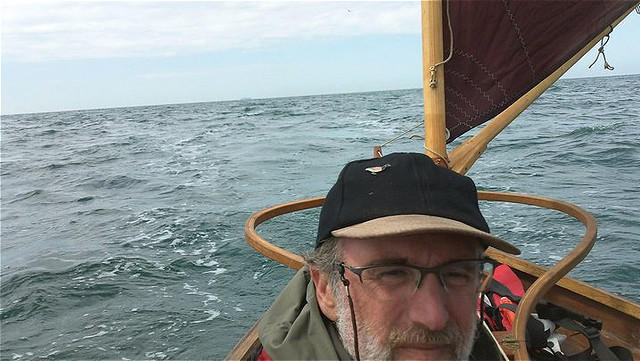
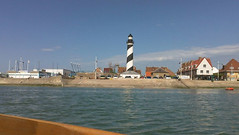
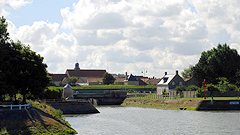 The access to the channel leading to Gravelines is a bit difficult, but we enter quite well, then we sail for the last 3 miles and dock in the wonderful Marine. Fantastic!
The access to the channel leading to Gravelines is a bit difficult, but we enter quite well, then we sail for the last 3 miles and dock in the wonderful Marine. Fantastic! We also discovered a 57 metres vessel, replica of the 18th century original, under construction: Impressive!
We also discovered a 57 metres vessel, replica of the 18th century original, under construction: Impressive! 
